The Gryphon In Heraldry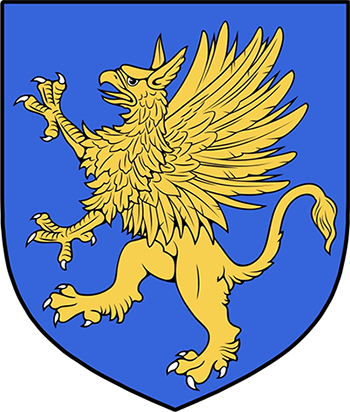 Read family coat of arms Being the regal and highly emblematic creature that it was, there is no surprise that the Gryphon quickly became associated with the symbolic art of Heraldry. In fact, the Gryphon is the most widely used "monster" in heraldry, just as the lion is the most widely used beast and the eagle the most widely used bird. Coincidence? I think not. Below you will find a small amount of heraldic history as it applies to the Gryphon, as well as some instances in which the Gryphon has been employed as a charge or supporter. But first, a bit of information on the art itself. A Short Heraldry PrimerThere is an amazing amount of jargon attributed to heraldry, as well as a multitude of rules on what can and can not be shown or done. There are, however, a small number of facts that one should know to be acquainted with the art, and only a few of those will I write of here. Firstly, know that the term blazon means the written description of a heraldic design, such as Azure a Griffin rampant Or. (Which also happens to be the arms granted to the Read family.) Using the above blazon, let's break it down into two describable parts. The first is the importance of colors, metals, or furs, otherwise known as tinctures. There are generally 9 accepted tinctures: 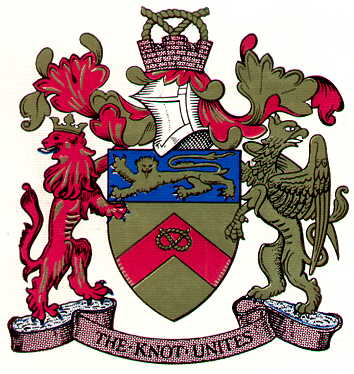 Staffordshire Arms
(There is also another commonly used term called proper, which simply denotes the charge's natural color. A Griffin proper would be a gold Gryphon.) Thus we see that the arms of Read family has two distinct tinctures, Azure a Griffin rampant Or.  Crew and Nantwich crest The next is the presence of a charge. A charge is nothing more than a figure represented on the shield, usually an animal. If the charge is an animal however, it is blazoned as performing some act, such as walking (passant), sitting (sejant), sleeping (dormant), etc. The most popular pose however, is rampant, which means that the creature is standing on one hind leg, as in the pic to the right, by Jill Johansen. (The term segreant is used exclusively with Gryphons as an alternate form of rampant.) If we were to transpose Read family arms into layman's terms, then it would be: On a blue background, there is a golden griffin standing up on one hind leg. One other important aspect is the determination of left and right, or in heraldry, sinister and dexter. The important thing to remember is that shields are blazoned from the view of the bearer, as if that person were physically behind the shield. Thus, in the picture of the Staffordshire arms to the left, the Gryphon is on the sinister side and the lion is on the dexter. (It should also be noted the two beasts are presented as regardant, or looking back over their shoulders.) A supporter is simply a beast, bird, person or thing that holds up a shield, usually in twos, as in Crew and Nantwich crest. Supporters were not used in early heraldry, and one of the first recorded grants of supporters to an individual was in 1508, to Sir Hugh Vaughn. Coincidentally, the Vaughn supporters were two Gryphons (with double tails) Goules fretty Or and semy of Roundels Argent (platey). (Think of a red Gryphon with gold criss-crosses and white spots.) For more information on heraldry, please check out the extensive heraldry glossary by James Parker, the most amazing and informative online resource I have found to date. The Heraldic Gryphon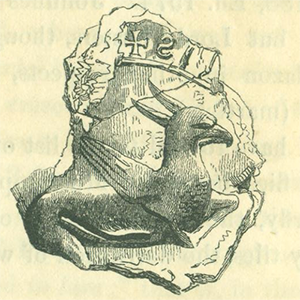 The seal of Richard de Redvers, Earl of Exeter, 1162. A couchant (lying down on all fours with an erect head) Gryphon is portrayed on the seal of Richard de Redvers, Earl of Exeter, and dated back to 1162 is the earliest example of the Gryphon's use as a charge or at least a symbol. (Heraldry itself is presumed to have begun in the mid-Twelfth Century.) In fact, the Gryphon may have been used by the Redvers (Reviers, Rivers) family before that. It is said that another Richard de Redvers, who died in 1107, had the arms granted Gules a Griffin segreant Or. (Note the extreme similarity to the arms of Read, above. The only difference is in the color of the background. This was a common and most confusing occurrence in early heraldry.) Unlike the myth itself, the heraldic Gryphon has a more or less stable appearance. It is always an eagle / lion hybrid, with the forepart, including the forepaws, like that of an eagle, and the hindpart like that of the lion. Also important is the presence of the sharp ears, which was the only way to distinguish a Gryphon's head erased (jaggedly cut off) or couped (a straight cut) from that of an eagle's, such as the arms of Skinner, Sable a Chevron Or. between three Griffin's heads erased Argent. (The chevron is an ordinary, or a geometrical charge.) | ||||||||||||||||||||||||||||||||||||
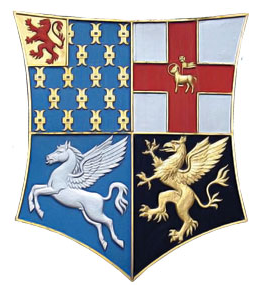 Inns of Court School of Law arms 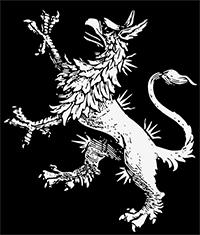 A Keythong, or male Gryphon There is, of course, an exception to the Gryphon's form, and that is when it is presented as a male. For some unknown reason, a male Gryphon is portrayed in heraldry without wings, having instead rays of sharp spikes coming out from various places on it's body. (Symbolically speaking they are rays of sunlight.) There are often times when a male Gryphon is also depicted with two horns and/or tusks. | ||||||||||||||||||||||||||||||||||||
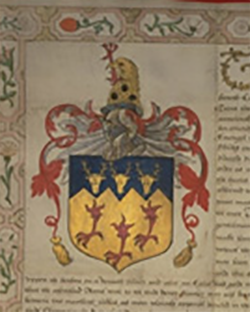
Stanley family coat of arms
The Gryphon was also popular as a badge, which is a free-standing heraldic device. A most unique badge can be found granted to Lord Stanley, temporary Edward IV, A Griffin's leg erased Gold. How one can accurately identify a Gryphon's leg I do not know. In fact, the Griffin's leg erased Gold is also characteristic of the entire Stanley coat of arms, as shown in the thumbnail to the left.
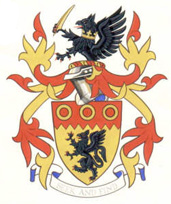
Griffiths family coat of arms
A classic Gryphon coat of arms is the arms of the Griffiths family. The arms are Or, a griffin segreant sable, on a chief indented gules three annulets or. The crest is A demi griffin sable holding in the dexter foreclaws a quill and gorged of an ancient crown or. The motto in the banner reads, "Seek and find".
Why use a Gryphon as a part of your coat of arms? The answer lies simply in the beneficial symbolic qualities of the beast. According to Joe Nigg,
"In the late fourteenth century, John de Bado Aureo wrote 'A Griffin borne in arms signifies that the first to bear it was a strong pugnacious man, in whom were found two distinct natures and qualities, those of the Eagle and the Lion.'"
Or you can take this excerpt from A Display of Heraldry, written in 1611 by John Guillim.
"He beareth, Or, a Griffon Rampand, with wings displayed [outspread], Sable, by the name of Morgan. The erecting of the fore-legs of this Griffon, is an evident testimony of his readiness for action, which addeth a second force to his attempt, and promiseth a successful event of his enterprise, by reason he uniteth force and industry together. The Griffon having attained his full growth, will never be taken alive; wherein he doth Adumbrate or rather lively set forth the property of a valorous souldier, whose Magnanimity is such as he had rather expose himself to all dangers, and even to death itself, than to become captive."
The Opinicus
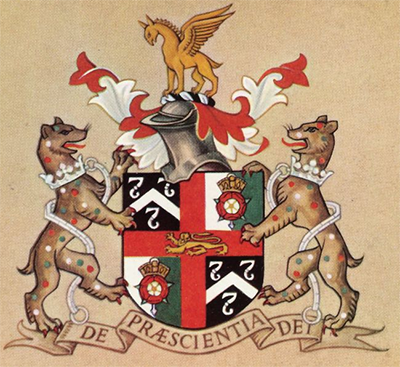
Blazon of the Company of the Barber Surgeons of London
Many unique and relatively unknown animals and monsters gained notoriety thanks to the creativeness of heraldry, such as the Theow, a wolf with cloven hooves; the Pantheon, a bushy tailed hind covered with stars; and the Opinicus; a "false Gryphon". The Opinicus of heraldry is very Gryphonesque, but has three distinct features: the head is that of an eagle (i.e. no Gryphon ears); the forepaws are those of a lion, not eagle; and the tail is thin and short like a camel's. The most famous Opinicus is that one attributed to the crest (a device mounted atop of a helmet) of the Company of the Barber Surgeons of London, An Opinicus with wings endorsed Or.
According to Joe Nigg
"...[The Opinicus] is also on the arms granted, in the twentieth century, to Sir Frederick Treve, the surgeon who performed a successful appendectomy on King Edward VII."
© 2019 James Spaid. All rights reserved.